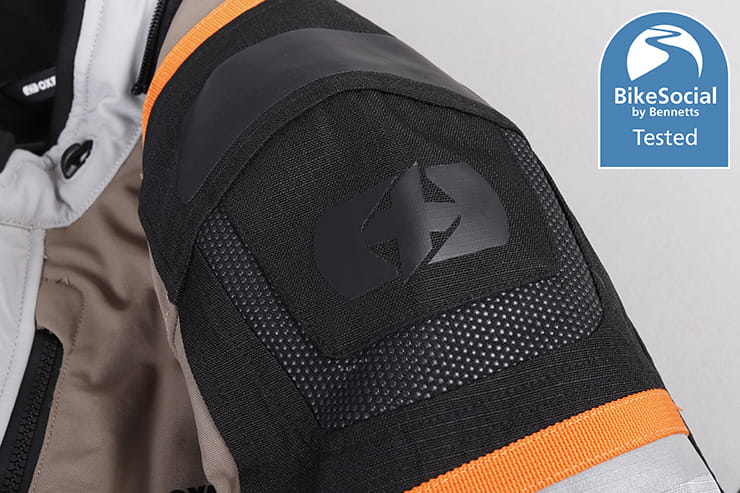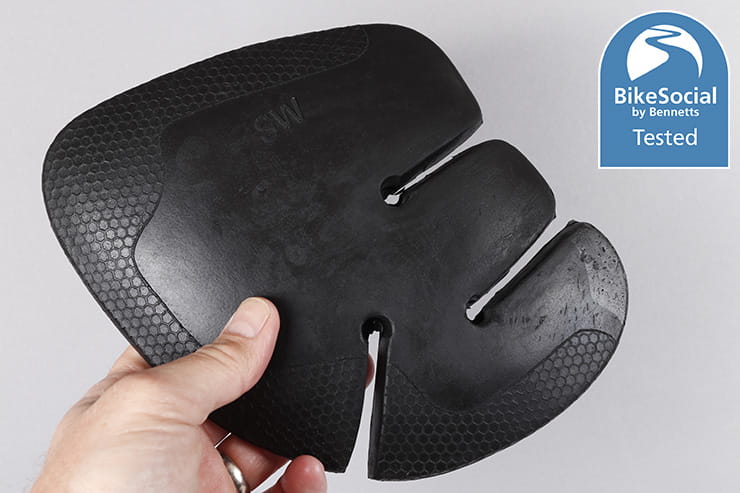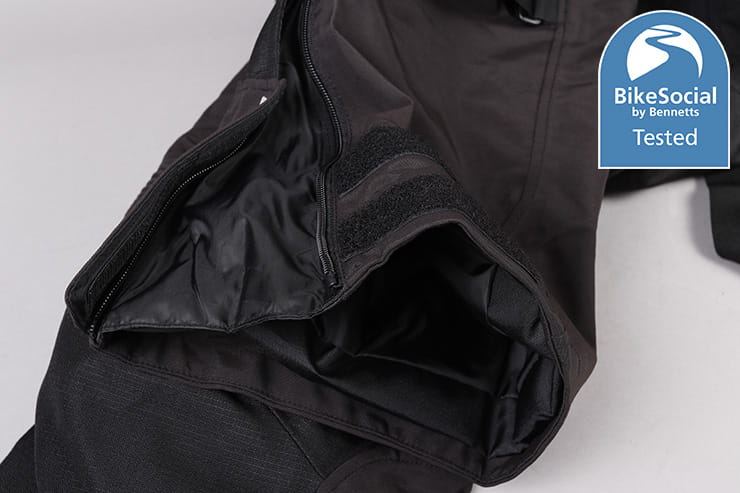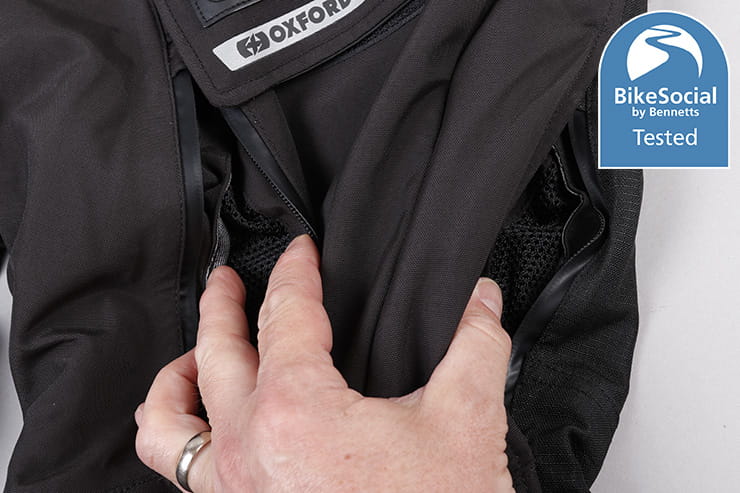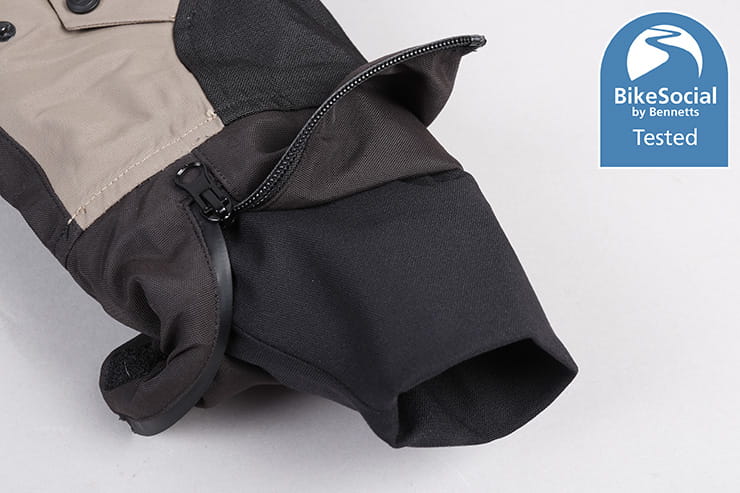Date reviewed: October 2023 | Tested by: Simon Roberts | Price: RRP £399.99 (jacket) & £299.99 (trousers) | www.oxfordproducts.com>
Oxford’s top-of-the-range Stormland D2D textile jacket and trousers have a whole suite of impressive features and meet the AA level of the CE standard for safety, with Level 2 impact armour protecting the shoulders, elbows, hips and knees. I’ve put both jacket and trousers to the test on a BMW R1200GS Adventure between July and October 2023, riding around 1,800 miles in all weathers, including some appalling and sustained wet weather.
Pros & Cons
- Fantastic wet weather performance
- Comfortable with excellent ventilation
- Reassuringly substantial feeling
- Low collar won’t suit everyone
- Removable neck gaiter is fiddly and feels cheap
- Insecure rear twin pocket
Construction and fit
The Oxford Stormland jacket and trousers are both constructed from heavy-duty nylon with Ripstop reinforcements in critical impact zones and SuperFabric overlays at the shoulders. The nylon outer is one of three layers that make up Oxford’s Dry2Dry Trilaminate material, which is protective, waterproof and breathable. Both jacket and trousers come with a removable thermal liner.
Sizes for both range from small to 5XL and the trousers are also available in short, regular or long leg (except 4XL and 5XL, which have no long option).
For my 5ft 9in and 86kg (13.5-stone) figure, I found a large-sized jacket was ideal when paired with large-sized trousers in the short-leg option.
Protection and certification
The Oxford Stormland jacket and trousers meet the AA level within the CE standard (AAA is the highest level, though it’s rare for textile garments to achieve it). The protectors at the shoulders, elbows, hips and knees meet CE Level 2, which is the highest level. Disappointingly a back protector is not supplied as standard, despite there being a pocket to accommodate one.
I found the positioning of the armour to be good when on the bike, which in the case of the knee protectors was helped by choosing a short-leg option.
The jacket also features a RECCO reflector that may help search and rescue teams find you in isolated areas or circumstances (see www.recco.com for more details).
Clearly, the vast majority of UK motorcyclists are unlikely to be buried in an avalanche, but getting into trouble while in a remote part of Scotland is not impossible and it’s a nice feature to have.
Both the jacket and trousers feature reflective strips, which improves rider visibility at night.
All motorcycle clothing sold in the UK and Europe is deemed to be Personal Protective Equipment (PPE). This is a good thing for riders as it can help them choose kit that has provable levels of safety because, to meet this legislation, it must be tested to a recognised standard. To fully understand the labels found in all bike kit, click here.
Pockets
The jacket has eight pockets in total. Six of them are external and you also have access to two of three internal pockets at any one time. External pockets are two on the front with Velcro fasteners, two side pockets with water-resistant zips and a pair of pockets on the rear, one of which is a mesh pocket for drying gloves. The internal pockets are a Napoleon pocket behind the main fastener, a large mesh pocket in the main liner and a duplicate of this in the thermal liner. All internal pockets are waterproof.
The trousers have four pockets. There are two front cargo pockets with pleated expansion and Velcro fastening, plus two side pockets with water-resistant zips.
I always assume external pockets are not waterproof, though I found the external pockets to be useful in number and well positioned.
I used the jacket side pockets a lot as the zipped entry made them secure, as I did the cargo pockets on the trousers, which were easily accessed via Velcro storm flaps.
However, as with many other adventure-style jackets, I found the front pockets lacked real utility as the fit was too tight against the main body of the jacket. Perhaps genuine pleated box-like pockets that will carry loads of stuff just don’t have the same aesthetic.
The internal pockets are waterproof as they’re behind the waterproof membrane. The Napoleon pocket is zipped and secure, but it’s small. The mesh pocket is well-sized and very useful, and the elasticated opening is easy to access.
The jacket comes with the obligatory rear ‘map’ pocket, though I don’t know anyone who uses them for that purpose. In my case I used this pocket to store the removable neck gaiter supplied with the jacket.
There is no closure on the rear pocket either, so it doesn’t feel very secure. The gaiter has stayed put as a result of a mesh pocket over the top, which secures with a single press stud.
I like the idea of having somewhere to store wet gloves, but this mesh pocket doesn’t feel secure without a zip and the fact the mesh pocket is out of sight (and out of mind) means you would be unlikely to know if a glove fell out.

Fastening
The jacket’s YKK primary zip has been faultless in operation (although I would have liked a chunkier specification) and this sits behind a substantial double storm flap that is secured via three Velcro strips. The jacket and trousers can be connected via long or short zips, both of which are manufactured by YKK. Zipping the jacket to the trousers via the long zip is easy enough and positively influenced by, firstly, the stretch in the materials and secondly the enhanced presentation angle at the start of the zip in the trousers. The trousers are fastened with a clever YKK closure that is very substantial.
Adjustment
The jacket has accordion stretch panels above the elbows, press stud adjustment at the forearms, a drawcord adjustable hem and webbing adjustment at both waist and the upper arms.
The collar has a Velcro fastener, which can be secured quite tightly if required or held open via an elasticated loop and hook. The collar does not have a five-point press stud fitting as stated on the product page of Oxford’s website at the time of review. The outer cuffs have a standard Velcro closure that allows for some adjustment.
The trousers have accordion stretch panels above the knees, stretch panels at the waist, rear of the knees and above the seat, and webbing adjustment at the waist and calf. They also come with adjustable and detachable braces, which are comfortable and effective.
Ventilation
Over and beyond the membrane’s good breathability specification (if you want to get technical it allows 10,000g of moisture per square metre to escape over a 24-hour period), the jacket has six direct ventilation points.
There are two large vents on the chest, two further large vents on the back and a pair of small vents on the upper arm.
The Stormland trousers have four direct ventilation points – two medium-sized vents on each leg. The chest vents deserve a special mention as they’re behind a water-resistant zip and Velcro fold-back flap, which is held up and away by a magnetic fastening when you open the vent. I was very sceptical about this, but not once did the magnet fail when I had the chest vents open.
The Stormland is a substantial textile suit, so I found the ventilation to be welcome and quite effective in hot weather, but it can never be as free-breathing as a summer-only mesh jacket.
Warmth
The Stormland’s tri-laminate structure makes the material completely windproof, so there’s zero windchill when the vents are closed.
The jacket and trousers come with Oxford’s WarmDry removable thermal liners, which also have sections made from Polartec Power Grid stretch fabric.
I found the liners to be lightweight, very comfortable and the stretch zones make a real difference.
In terms of warmth, I found the thermal liner for the trousers worked exceptionally well. For the jacket, the liner does a good job too although it’s not quite in the same league as a separate down or synthetic mid-layer.
Liner
The liner used in the jacket and trousers is fixed and is predominantly made from a close-knit material that is noticeably soft next to the skin. In the crotch of the trousers there is also some additional mesh-like material that is stretchy, lightly padded and particularly comfortable.
Waterproofing
The Stormland’s tri-laminate material carries a laboratory waterproof specification of 10,000mm static head, which makes it highly waterproof but not exceptionally so if the hydrostatic head testing methodology is to be our guide. Waterproof clothing ranges from a 3,000mm static head rating up to 20,000mm or more.
Back in the real world, the Stormland has proven completely waterproof and has not once let me down. This includes a 350-mile trundle from high, technical passes in the Lakes to North Wales in the worst wind and rain I have ever ridden in (you know it’s serious weather when cars are doing 30mph on the M6).
The substantial nature of the Stormland gives a very reassuring feel in such conditions, and while the neck gaiter is fiddly to attach and looks cheap, it did the job. I half expected water to leak in through the chest vents and numerous water-resistant zips, but I was wrong – to date I’ve been 100% dry.
The cuffs are a real specification highlight and are very similar to those found on Rukka’s £1,550 Kingsley jacket.
They are a two-piece design with a soft elasticated inner running up to your lower forearm, whilst the jacket’s waterproof outer goes over your gloves and then cinches tight via a water-resistant zip and Velcro tab.
The result is a waterproof and windproof seal between glove and jacket – genius. My only slight criticism is that a really thick pair of winter gloves may test that water-resistant zip as there’s little surplus material. If you prefer to wear your gloves on the outside then the cuffs cinch down with minimal bulk.
Three alternatives to the Oxford Stormland
If you’re in the market for an all-round do-it-all textile for similar money then you’re spoilt for choice. Here are some other options to think about…
These are just three of many alternatives – you can find all the motorcycle textiles we’ve tested here and be sure to regularly check for the discounts available through Bikesocial membership.

Oxford Stormland review | Verdict
Oxford’s current crop of laminated rider wear has proven to be a huge hit with those looking for a great specification at a certain price. The Stormland is now its flagship textile jacket and based on my experience over the last four months it offers a specification, performance level and comfort that’s significantly above its price tag.
The Stormland is not perfect – its heavy and substantial construction is a bit old-school, the low collar won’t suit everyone and I’d like the pockets to be more usable.
Ideally I’d also like to see a higher specification of thermal liner in the jacket and a chunkier main zip as well.
However, these criticisms are totally outweighed by the waterproofing, the CE pass to AA grade and CE Level 2 impact protection, a long list of features and the detail that has gone into the design. I would also highlight the fact that it’s just very comfortable to wear day in, day out.
If you’d like to chat about this article or anything else biking related, join us and thousands of other riders at the Bennetts BikeSocial Facebook page.





